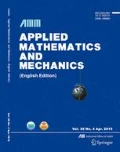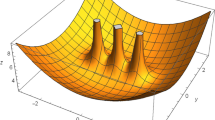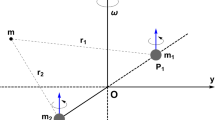Abstract
This paper discusses the region of possible motion of planar circular restricted three-body problem that one primary in them has a ring and it gives the equation of motion of the third body. Some results are as follows:
-
(1)
The location of equilibrium points depends on the parameter μ of the system; inner radiusa and outer radiusb of the ring; the distancel between two primaries; and the ratio θ of the mass of the ring with the sum of masses of the primary which has the ring and the ring itself. Whena, b, l, θ are constant, the number of the equilibrium points varies with μ, it is five at most and three at least. Besides each triangular point and two primaries form an isosceles triangle.
-
(2)
Whena, b, l, θ are constant, we give a range of μ. If μ is in this range, the structure of the region of possible motion of the third body is the same as that of general planar circular restricted three-body problem.
Similar content being viewed by others
References
Szebehely, V., Theory of Orbits, Academic Press, New York, (1967).
Bhatnagar, K. B. and Chawla, J. M., Celes, Mech, 16, (1977), 129–136.
Author information
Authors and Affiliations
Additional information
Communicated by Dong Jin-zhu.
Rights and permissions
About this article
Cite this article
Xiang-ling, Z. The region of possible motion of the planar circular restricted three-body problem under the influence of a ring. Appl Math Mech 3, 393–404 (1982). https://doi.org/10.1007/BF01897221
Received:
Issue Date:
DOI: https://doi.org/10.1007/BF01897221




